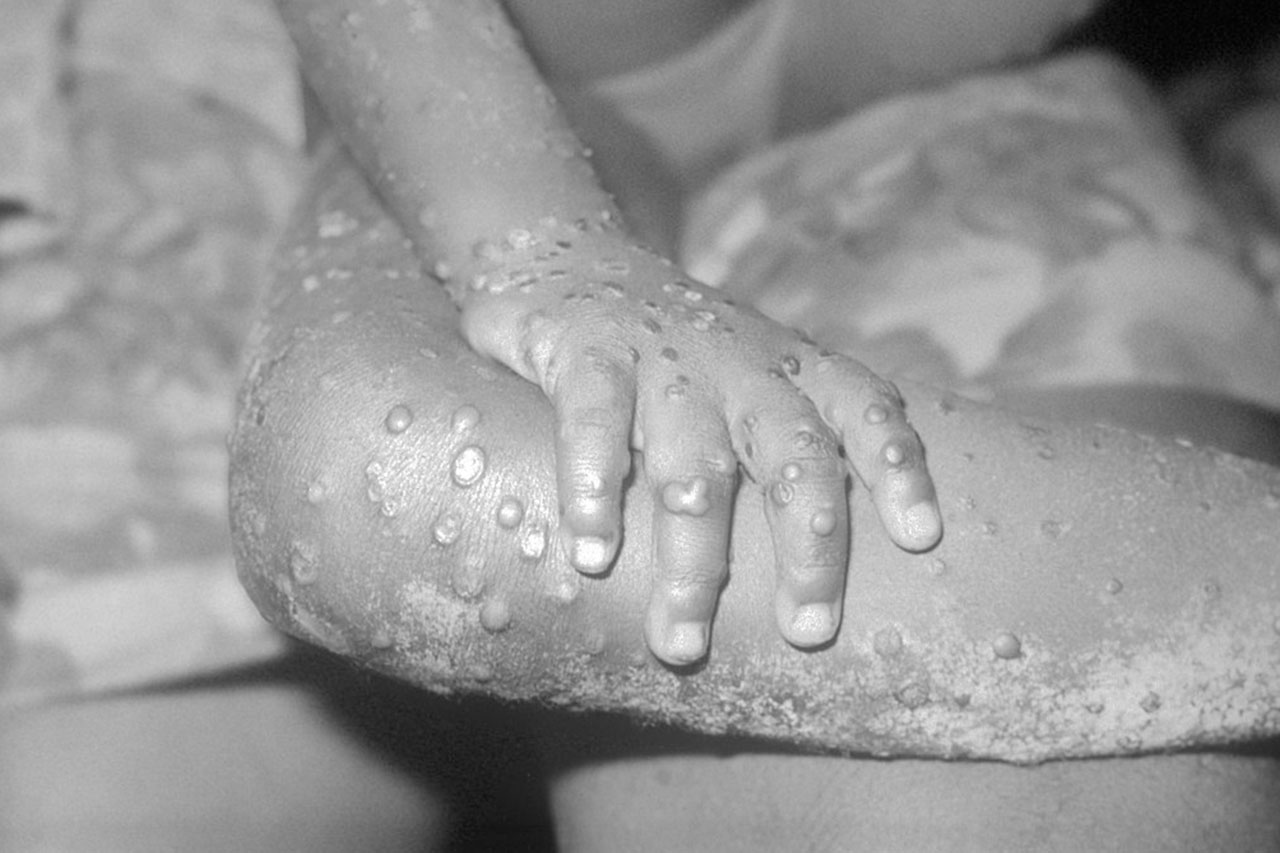
Author CDC/ Cynthia S. Goldsmith, Inger K. Damon, and Sherif R. Zaki
As cases of monkeypox in wealthier Western nations spark a flurry of scientific research to combat the outbreak, scientists are urging the world to make sure lower-income nations benefit from the fruits of that labour as well. More than 550 confirmed cases of monkeypox have been reported by at least 30 countries outside of Africa, where the virus is typically found, according to the World Health Organization (WHO).
In a new risk-assessment document, the European Centre for Disease Prevention and Control (ECDC) summarises what we currently know about monkeypox and recommends that European countries focus on the identification and management of the disease as well as contract tracing and prompt reporting of new cases of the virus. (www.medscape.com/viewarticle/974944?src=mkm_ret_220604_mscpmrk_covid-ous_int&uac=398271FG&impID=4299686&faf=1)
Monkeypox appears to be spreading from person to person in England, the UK Health Security Agency (UKHSA) said on Wednesday. The usually mild viral disease, which is endemic in west and central Africa, is understood to spread through close contact. Until early May, cases rarely cropped up outside Africa and were typically linked to travel to there. “The current outbreak is the first time that the virus has been passed from person to person in England where travel links to an endemic country have not been identified,” the agency said.
From May 15 to May 23, in eight European Union (EU) member- states (Belgium, France, Germany, Italy, the Netherlands, Portugal, Spain, and Sweden) a total of 85 cases of monkeypox were reported; they were acquired through autochthonous (indigenous) transmission. Current diagnosed cases of monkeypox have mainly been recorded in men who have sexual relations with men, suggesting that transmission may occur during sexual intercourse, through infectious material coming into contact with mucosa or damaged skin, or via large respiratory droplets during prolonged face-to-face contact.
Andrea Ammon, MD, director of the ECDC, stated that “most current cases have presented with mild symptoms of the disease, and for the general population, the chance of diffusion is very low. However, the likelihood of a further spread of the virus through close contact, for example during sexual activities among people with multiple sexual partners, is considerably increased.”
Monkeypox is not easily spread among people. The incubation period is 5-21 days, and patients are symptomatic for 2-4 weeks.
According to the ECDC, the likelihood of this infection spreading is increased among people who have more than one sexual partner. Although most current cases present with mild symptoms, monkeypox can cause severe disease in some groups (such as young children, pregnant women, and immunosuppressed people). However, the probability of severe disease cannot yet be estimated precisely.
The overall risk is considered moderate for people who have multiple sexual partners and low for the general population.
The disease initially presents with fever, myalgia, fatigue, and headache. Within 3 days of the onset of the prodromal symptoms, a rash appears on the site of primary infection and rapidly spreads to other parts of the body. The palms of the hands and bottoms of the feet are involved in cases where the rash has spread, which is a characteristic of the disease. Usually within 12 days, the lesions progress, simultaneously changing from macules to papules, blisters, pustules, and scabs before falling off. The lesions may have a central depression and be extremely itchy.
The onset of the rash is considered the start of the infectious period; however, people with prodromal symptoms may also transmit the virus. The death rate ranges from 0% to 11% in endemic areas, with fatalities from the disease mostly occurring in younger children.
No smallpox vaccines are authorised for use against monkeypox, however the third-generation smallpox vaccine Imvanex (Modified Vaccinia Ankara) has been authorised by the European Medicines Agency (EMA) for the EU market against smallpox and has demonstrated to provide protection in primates.
In regard to treatment, tecovirimat is the only antiviral drug with an EMA-authorised indication for orthopoxvirus infection.
Brincidofovir is not authorised in the EU but has been authorised by the US Food and Drug Administration. However, availability on the European market is limited somewhat by the number of doses.
A potential risk for human-to-animal transmission exists in Europe; therefore, a close collaboration is required between human and veterinary healthcare authorities, working together to manage domestic animals exposed to the virus and to prevent transmission of the disease to wildlife. To date, the European Food Safety Authority is not aware of any reports of animal infections (domestic or wild) within the EU.
If human-to-animal transmission occurs and the virus spreads among animal populations, there is a risk that the disease could become endemic in Europe.
////
Outbreaks of endemic diseases such as monkeypox and lassa fever are becoming more persistent and frequent, the WHO’s emergencies director, Mike Ryan, warned on Wednesday. (www.medscape.com/viewarticle/974885?src=wnl_edit_tpal&uac=398271FG&impID=4301091&faf=1)
As climate change contributes to rapidly changing weather conditions like drought, animals and human are changing their behaviour, including food-seeking habits. As a result of this “ecologic fragility”, pathogens that typically circulate in animals are increasingly jumping into humans, he said.
“Unfortunately, that ability to amplify that disease and move it on within our communities is increasing – so both disease emergence and disease amplification factors have increased.”
For instance, there is an upward trend in cases of lassa fever, an acute viral illness spread by rodents endemic to Africa, he said.
“We used to have three to five years between Ebola outbreaks at least, now it’s lucky if we have three to five months,” he added.
“So there’s definitely ecological pressure in the system.”
Ryan’s commentary comes as cases of monkeypox continue to rise outside Africa, where the pathogen is endemic.
////
As many Shanghai residents rushed onto the streets this week to reunite with friends and pop champagne to celebrate the end of a two month-long lockdown, Li Menghua was busy packing up his hair salon, a casualty of the draconian quest to stamp out COVID-19. Li, 24, set up his salon three years ago after leaving home in Henan province to seek his fortune in China’s largest and most prosperous city. “Our business was really good, always busy with customers. But because of the pandemic, a lot of shopfronts have to close,” he said.
https://www.reuters.com/world/china/after-shanghai-lockdown-many-struggle-pick-up-pieces-2022-06-02/
Shanghai has begun easing one of the world’s longest, toughest lockdowns since the pandemic began. Many of its 25 million residents basked in their newfound ability to move around freely.
As the rules took effect overnight, residents honked horns and set off fireworks. As the sun rose, they strolled and cycled through their city like dazed tourists. During the day, people — all wearing masks — revelled in the novelty of previously mundane pleasures like meeting friends and relatives, walking in parks, and driving through streets that had been largely empty for weeks.
The stringent two-month lockdown sparked public anger over shortages of food and medicine. Some residents with chronic illnesses were denied entry to hospitals, sometimes with deadly consequences.
In early April, Shanghai ordered residents to stay home and businesses to shut to try to stifle the spread of the Omicron variant. City leaders had initially said they could contain the outbreak with limited restrictions, but China’s leader, Xi Jinping, ordered tougher measures as infections climbed to more than 20,000 each day. New daily infections have now fallen to low double digits.
Though the lockdown is over, it has brought changes in the relationship between the Chinese government and its people that is unlikely to disappear overnight. The Shanghai lockdown set off small-scale protests that unsettled Communist Party officials. Whether such frustration will linger is hard to say.
Meanwhile, Beijing will further relax COVID-19 curbs by allowing indoor dining, as China’s capital steadily returns to normal with inflections falling, state media said on Sunday. Beijing and the commercial hub Shanghai have been returning to normal in recent days after two months of painful lockdowns to crush outbreaks of the Omicron variant. Dine-in service in Beijing will resume on Monday, except for the Fengtai district and some parts of the Changping district, the Beijing Daily said. Restaurants and bars have been restricted to takeaway since early May.
///
Lalita Panicker is Consulting Editor, Views and Editor, Insight, Hindustan Times, New Delhi





